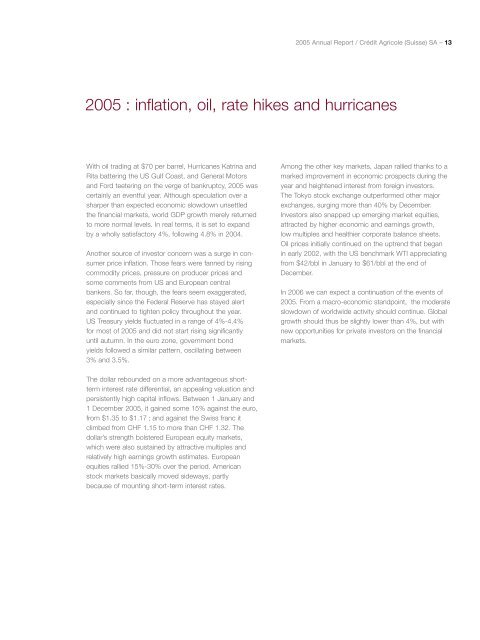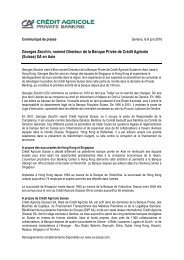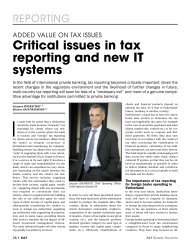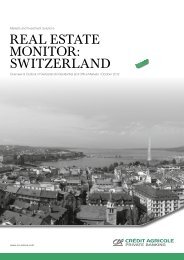2005 Annual Report / Crédit Agricole (Suisse) SA
2005 Annual Report / Crédit Agricole (Suisse) SA
2005 Annual Report / Crédit Agricole (Suisse) SA
- No tags were found...
You also want an ePaper? Increase the reach of your titles
YUMPU automatically turns print PDFs into web optimized ePapers that Google loves.
<strong>2005</strong> <strong>Annual</strong> <strong>Report</strong> / Crédit <strong>Agricole</strong> (<strong>Suisse</strong>) <strong>SA</strong> – 13<strong>2005</strong> : inflation, oil, rate hikes and hurricanesWith oil trading at $70 per barrel, Hurricanes Katrina andRita battering the US Gulf Coast, and General Motorsand Ford teetering on the verge of bankruptcy, <strong>2005</strong> wascertainly an eventful year. Although speculation over asharper than expected economic slowdown unsettledthe financial markets, world GDP growth merely returnedto more normal levels. In real terms, it is set to expandby a wholly satisfactory 4%, following 4.8% in 2004.Another source of investor concern was a surge in consumerprice inflation. Those fears were fanned by risingcommodity prices, pressure on producer prices andsome comments from US and European centralbankers. So far, though, the fears seem exaggerated,especially since the Federal Reserve has stayed alertand continued to tighten policy throughout the year.US Treasury yields fluctuated in a range of 4%-4.4%for most of <strong>2005</strong> and did not start rising significantlyuntil autumn. In the euro zone, government bondyields followed a similar pattern, oscillating between3% and 3.5%.Among the other key markets, Japan rallied thanks to amarked improvement in economic prospects during theyear and heightened interest from foreign investors.The Tokyo stock exchange outperformed other majorexchanges, surging more than 40% by December.Investors also snapped up emerging market equities,attracted by higher economic and earnings growth,low multiples and healthier corporate balance sheets.Oil prices initially continued on the uptrend that beganin early 2002, with the US benchmark WTI appreciatingfrom $42/bbl in January to $61/bbl at the end ofDecember.In 2006 we can expect a continuation of the events of<strong>2005</strong>. From a macro-economic standpoint, the moderateslowdown of worldwide activity should continue. Globalgrowth should thus be slightly lower than 4%, but withnew opportunities for private investors on the financialmarkets.The dollar rebounded on a more advantageous shortterminterest rate differential, an appealing valuation andpersistently high capital inflows. Between 1 January and1 December <strong>2005</strong>, it gained some 15% against the euro,from $1.35 to $1.17 ; and against the Swiss franc itclimbed from CHF 1.15 to more than CHF 1.32. Thedollar’s strength bolstered European equity markets,which were also sustained by attractive multiples andrelatively high earnings growth estimates. Europeanequities rallied 15%-30% over the period. Americanstock markets basically moved sideways, partlybecause of mounting short-term interest rates.







